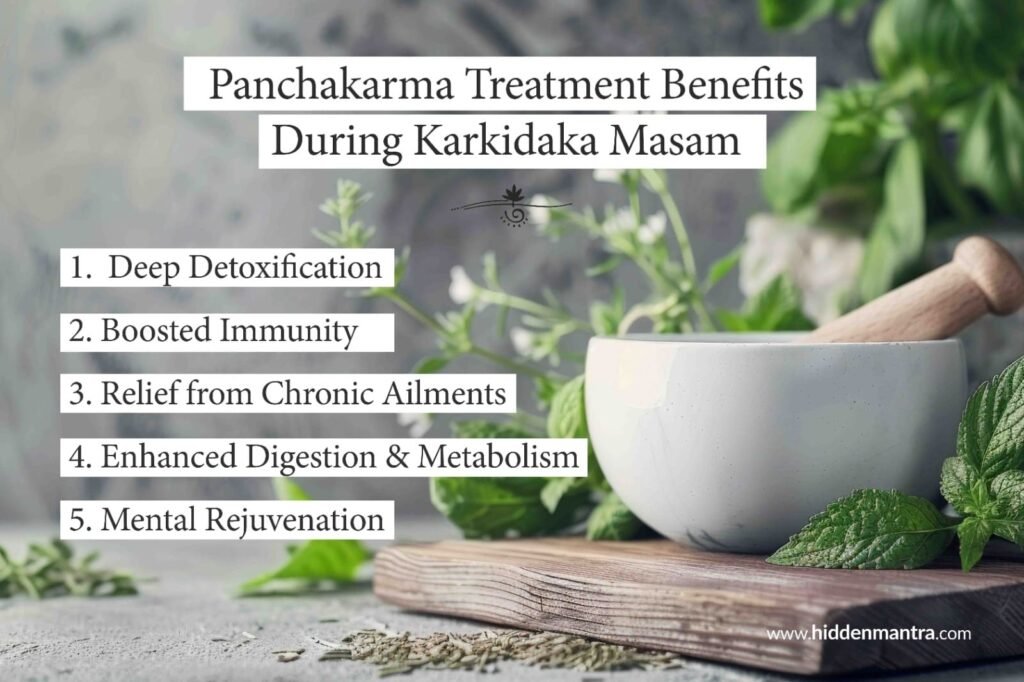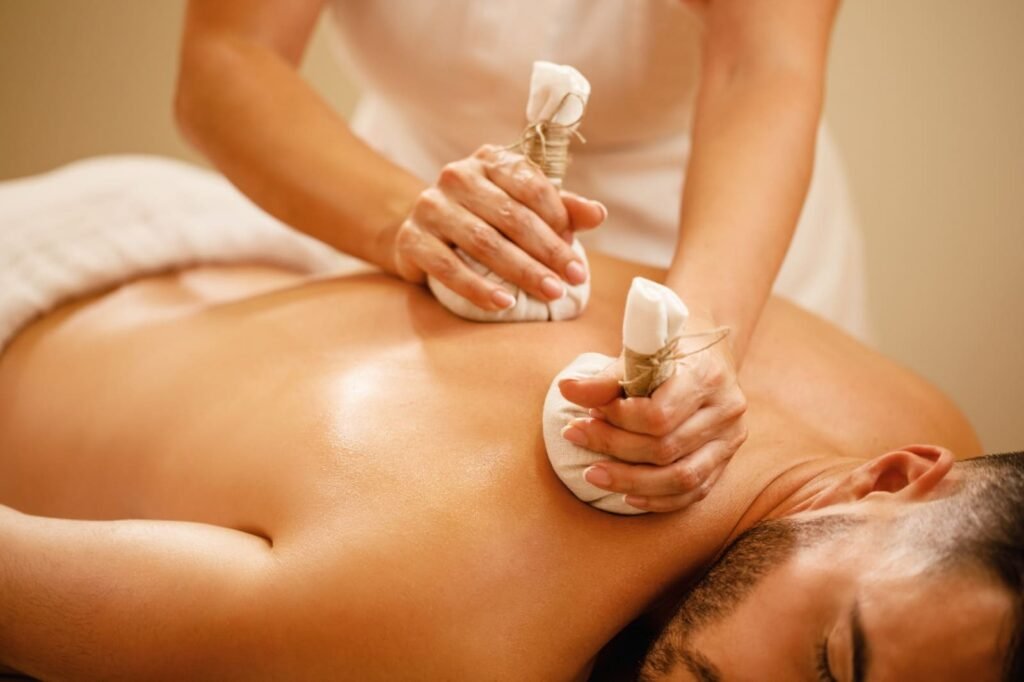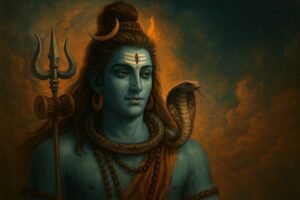Table of Contents
ToggleKarkidaka Masam, also known as Ramayana Masam, is the Kerala monsoon month (June-August), when Ayurveda recommends intensive detox and healing treatments. In this season, Panchakarma treatment becomes especially effective due to the body’s heightened receptivity. In this post, we’ll explore what makes Karkidaka ideal for Panchakarma therapy, define the treatment, and highlight its key benefits, such as deep detoxification, immunity boost, relief from chronic ailments, better digestion, and mental rejuvenation.
Why Karkidaka Masam is Ideal for Panchakarma
- High Humidity Enhances Absorption: The monsoon climate softens your skin and opens your channels (srotas), making oil-based therapies more effective
- Dosha Imbalances Peak: Vata and Kapha tend to get aggravated in Karkidaka, leading to digestive issues, respiratory problems, and fatigue. Panchakarma helps restore balance
- Body Primed for Detox: During monsoon, toxins (ama) accumulate; Panchakarma effectively flushes these out while the body is most receptive
What is Panchakarma Treatment?
Panchakarma is a classical Ayurvedic healing method that focuses on deep detoxification, rejuvenation, and balance of the body and mind. The word “Panchakarma” literally translates to “five actions”, referring to the five primary procedures used to eliminate accumulated toxins (Ama) and restore the natural balance of the doshas Vata, Pitta, and Kapha.
These five therapies are not just physical detox processes but holistic treatments that address digestive health, mental clarity, immunity, and energy flow:
1. Purvakarma – Preparatory Procedures
Before the main detox begins, the body is prepared using two important steps:
- Snehana (Oleation): This is the process of applying medicated oils both externally on the body and internally through specific ghee or oil preparations. It helps to soften the tissues, dissolve deep-seated toxins, and prepare them for easy elimination.
- Swedana (Fomentation): After oleation, herbal steam therapy is used to gently open the body’s channels (srotas), promote sweating, and guide loosened toxins toward the digestive tract for removal through the main Panchakarma procedures.
2. Vamana – Therapeutic Emesis
This is a medically supervised vomiting technique that helps expel excess Kapha dosha, phlegm, and deep-rooted toxins from the upper gastrointestinal tract and respiratory system. Ideal for conditions like asthma, sinusitis, obesity, and skin issues.
3. Virechana – Medicated Purgation
Focused on purifying the liver and intestines, Virechana involves herbal laxatives to eliminate excess Pitta dosha. It is especially effective for skin conditions, acidity, liver problems, and digestive disorders.
4. Nasya – Nasal Detox
In this therapy, medicated oils, herbal powders, or fresh plant extracts are gently introduced through the nasal passages to cleanse and revitalize the head and sinus region. It clears toxins from the head, neck, and sinus region, improves memory and concentration, and helps manage headaches, migraines, and allergies.
5. Basti – Ayurvedic Enema
Considered one of the most powerful Panchakarma treatments, Basti uses herbal oils or decoctions administered through the rectum to thoroughly detoxify the colon and restore balance to the Vata dosha. It targets Vata dosha imbalance and is used for arthritis, neurological issues, constipation, and chronic back pain.
Panchakarma Treatment Benefits During Karkidaka Masam

1. Deep Detoxification
Monsoon months soften bodily channels it makes it easier for toxins to be released through oil therapies, steam, and cleanse procedures.
2. Boosted Immunity
By rebalancing doshas and clearing toxins, Panchakarma strengthens Ojas (vital immunity), reducing susceptibility to seasonal illnesses
3. Relief from Chronic Ailments
Helps with respiratory issues, arthritis, skin problems, digestive disorders, and stress-related conditions commonly aggravated during monsoon
4. Enhanced Digestion & Metabolism
Improves Agni (digestive fire) through purification and Ayurvedic diet guidance -including Karkidaka Kanji and herbal decoctions
5. Mental Rejuvenation
A combination of Panchakarma, meditation, yoga, and restful routines helps reduce stress, promote clarity, and rejuvenate the mind
Additional Benefits & Practices to Include
Karkidaka Kanji & Herbal Diet
This herbal porridge, made with Njavara rice and medicinal spices, helps boost immunity, supports digestive health, and provides deep nourishment to the body.
Lifestyle & Regimen Changes
Include moderate yoga, meditation, light meals, and dosha-friendly routines. Avoid heavy foods, midday sun, and stressful activities
Embrace Ayurveda Panchakarma This Karkidakam
Karkidakam, the healing month in Kerala’s Ayurvedic calendar, offers the perfect time to slow down, reset your health, and realign with nature. To get the maximum benefit from Panchakarma therapy during this sacred season, it’s important to follow a structured and personalized approach that supports both body and mind.
1. Consult a Qualified Ayurvedic Practitioner
No two individuals are the same. Your Panchakarma plan should be based on your unique dosha constitution (Vata, Pitta, or Kapha), existing health concerns, age, and lifestyle. A certified Ayurvedic doctor will evaluate your body type (Prakriti) and current imbalances (Vikruti) before recommending the ideal therapy combination.
2. Select the Right Treatment Duration
Panchakarma is most effective when done without rush. Depending on your health condition, it can span across:
- 7 days – Basic detox and rejuvenation
- 14 days – For moderate ailments and dosha imbalances
- 21–28 days – For chronic conditions and deep-rooted toxins
Longer durations allow for complete cleansing, cellular rejuvenation, and a stronger post-therapy recovery.
3. Follow a Healing Monsoon Diet
Your digestive fire (Agni) plays a central role during Panchakarma. A dosha-specific monsoon diet will be prescribed, usually including:
- Karkidaka Kanji (medicated rice porridge with herbs)
- Herbal decoctions like Dashamoolarishtam or Jeeraka water
- Light, warm meals, avoiding fried, cold, or processed foods
This diet supports detoxification while nourishing and stabilizing your system.
4. Commit to a Rejuvenation Routine
Panchakarma goes beyond simple detox it’s a complete rejuvenation of the body, mind, and spirit. Include daily practices like:
- Abhyanga, the therapeutic application of warm herbal oils, helps soothe the nervous system and deeply nourish muscles and tissues.
- Swedana (herbal steam) to open pores and release toxins
- Gentle yoga and pranayama to balance energy and improve circulation
- Meditation or chanting for mental clarity and emotional calmness. This mind-body routine enhances the effects of detox and speeds up healing.
5. Prioritize Aftercare (Paschatkarma)
Post-Panchakarma care is as important as the therapy itself. To maintain results:
- Avoid heavy exertion, exposure to cold, or overstimulation
- Stick to warm, cooked meals and stay hydrated with herbal teas
- Gradually reintroduce regular foods and routines
- Enhance your digestive strength and immune system with specially recommended Rasayanas’ powerful rejuvenating herbal formulations in Ayurveda.
Conclusion
Karkidaka Masam is the perfect season for deep Panchakarma treatment because of increased humidity, balanced detox pathways, and peak dosha imbalance. The monsoon environment amplifies the treatment’s effectiveness, making it ideal for comprehensive detox, enhanced immunity, relief from chronic health issues, improved digestion, and mental clarity. Adopting Ayurvedic dietary habits, mindful lifestyle routines, and holistic Panchakarma practices during this month can lead to profound rejuvenation and year-round wellness.
To further support your healing journey, explore our guide on the Ayurvedic Morning Routine to start your day in balance and harmony.
For more insightful blogs on Ayurveda and wellness, visit HiddenMantra.com.
Interested in going deeper into this ancient science? Join our Ayurveda Courses and start learning how to live and share holistic healing the traditional way.








